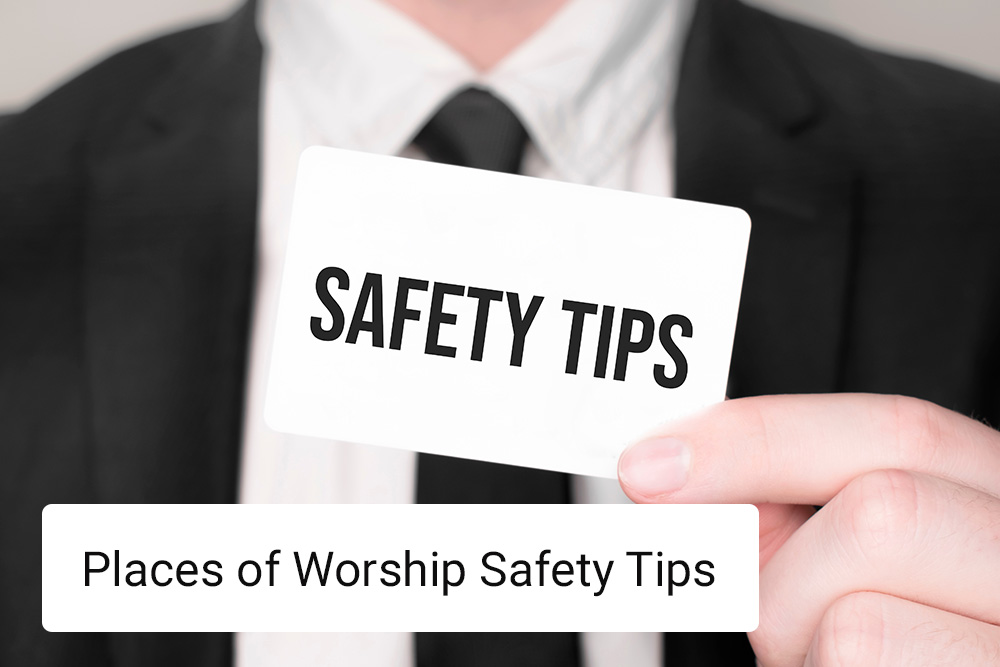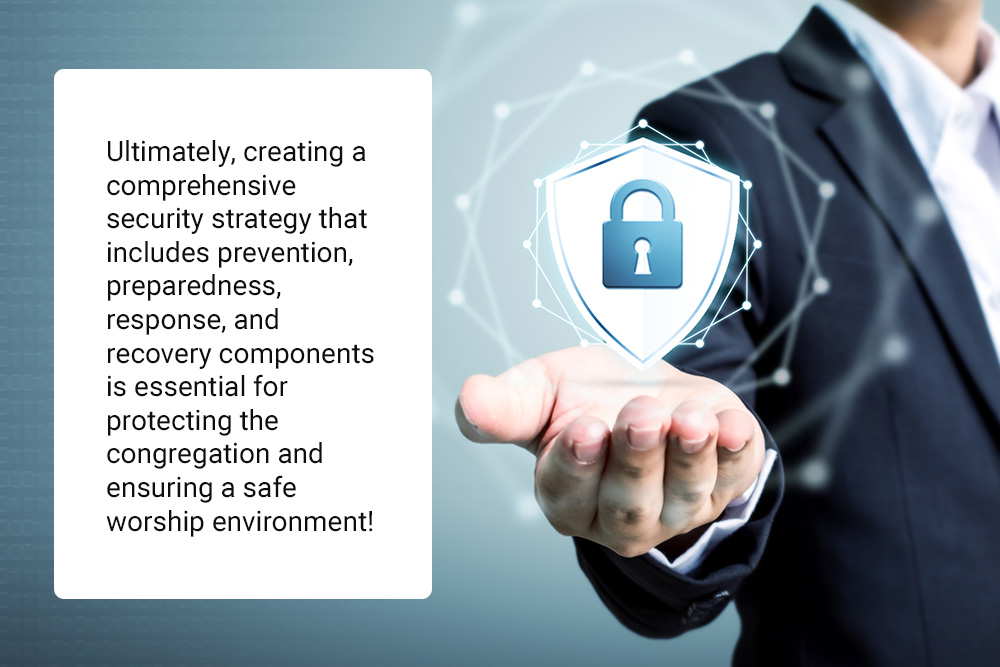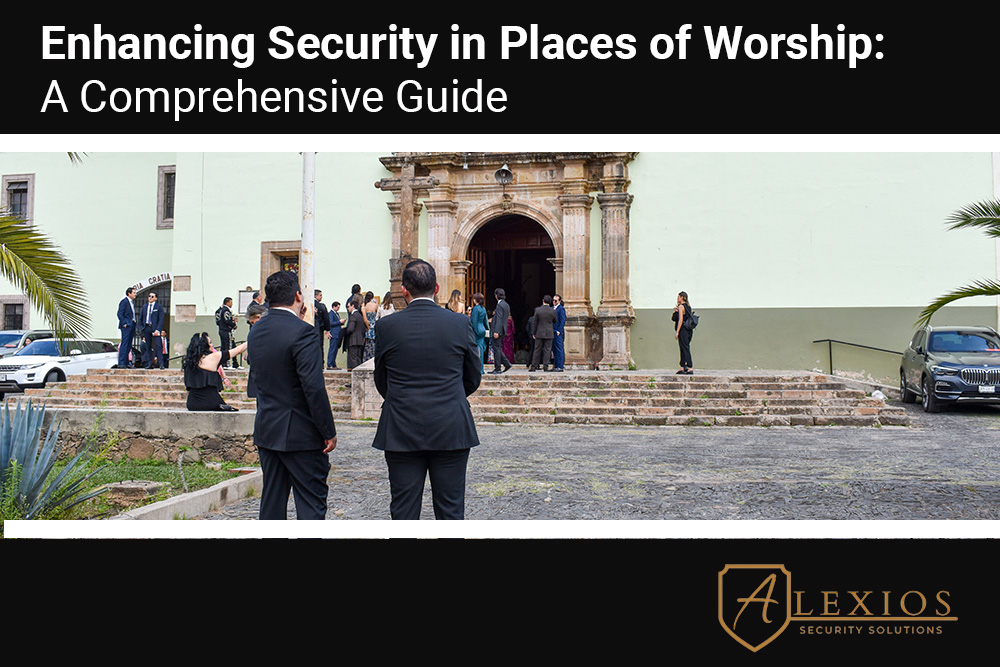When people enter a house of worship, they expect to find friends, spiritual connections, and fellowship. Unfortunately, there is always the chance that a dangerous or threatening situation could arise.
Let’s look at some crime statistics and then we’ll explore a few ways that places of worship can protect themselves and their members in a variety of situations.
House of Worship-Related Statistics
According to the US Department of Justice, 17.3% of all hate crimes were committed based on the victim’s religious beliefs in 2022. These represent over 2,000 separate instances across the country that involved damage to a person or property.
Another report by Lifeway Research states that 57% of Protestant pastors surveyed stated that their church had an active shooter response plan in place, 20% had armed private security officers on site, and 5% had uniformed police officers on site. Roughly 40% stated that they had little to no security measures in place.
Although this survey only involved Christian Protestant pastors in the United States, let’s assume these numbers are true across all religions and associated buildings in the country. That would mean of the 350,000 estimated places of worship in the United States, 140,000 have little to no security plans in place.
Church Security Systems
For most places of worship, burglaries will be the most common type of crime committed. Because many religions accept offerings or tithes in the form of cash, it can make an easy target for thieves.
It may be hard to imagine that criminals would choose a place of worship like a church, synagogue, mosque, or other house of worship to steal from, but many thefts are crimes of opportunity. Thieves love easy targets with little chance of getting caught and may imagine that if a priest or other church leader catches them in the act, they may choose forgiveness and not contact law enforcement.
First, after all offerings, tithes, or other monetary contributions are counted after the service, they should be taken to a bank or another financial institution immediately. Ideally, one of the offering counters or a member of leadership can place it in a night deposit dropbox on their way home.
Also, any religious artifacts, communion wine, or anything else that might make an attractive target for thieves should be secured in a locked cabinet or other storage device or stored in the home of a clergy member.
Active Shooter Training
Depending on where the place of worship is located, it may be a good idea to have select members of the congregation attend active shooter training. Depending on the faith, this could be a pastor, a priest, an elder, a deacon, or another leader.
If threats have been made or there is another reason to suspect that a violent incident could occur, having licensed security guards with concealed weapons strategically located in the sanctuary might be a good idea. A quality security services firm can help plan these logistics, as the layout of each individual building will be different.
Safety Ministry
Another good idea might be to set up a safety ministry, committee, or something with a similar title that focuses on strategies to keep worshippers and church property safe. With the importance of safety, it probably won’t be difficult to get volunteers.
This committee should receive extensive safety training on a variety of different scenarios, from breaking and entering to more violent confrontations. In addition to active shooter training, they should also get Active Violence Preparedness training, as a potential attacker could have a knife, club, or other weapon instead of a gun.
It’s also a good idea to have multiple people CPR-certified if a situation should arise, as it’s always possible that someone could be sick, out of town, or miss a week for other reasons. In a particularly bad situation, there may also be multiple people in need of assistance.
Balancing Safety with Fear
There is a delicate balancing act that must take place between safety and causing fear in the congregation. On one hand, having armed guards and a metal detector at the front door would drastically reduce the possibility of an incident. However, it may also scare away visitors or church members.
Conversely, having no security at all might make members of the congregation, and guests feel welcome but could present a problem if a situation does arrive that could have been prevented by implementing safety measures.
If there is an active threat, the building is in an unsafe neighborhood, or there’s another reason to suspect a situation could occur, having visible security can be useful as a deterrent. However, in other cases, the ideal security setup will remain largely unseen.
When new security measures are introduced, it may be a good idea to have a member of the clergy explain them to the congregation. Some members may feel like the church doesn’t trust them or that an active threat has occurred that inspired these measures. They should be reassured that the measures are only designed to protect the church and its members. Safety should be the highest priority, regardless of context.
Places of Worship Safety Tips
-
Try to avoid leaving valuable items or money lying around in the building when possible.
-
Installing a security system with cameras can help prevent break-ins or catch thieves in the attempt, especially if the parsonage, rectory, or other leadership quarters aren’t attached.
-
If the church provides housing for the leader of the clergy, it may also be a good idea to have a security system installed in those locations as well, as they may be targeted by criminals due to their positions.
-
Partnering with a private security services company can help eliminate any security flaws and reduce liability for the church in the event of an incident.
-
All security measures should be thoroughly tested before implementation. This will help reveal any errors or oversights that may have been made in the plan.
-
A Religious Facility Security Plan is a basic template that can be used to help craft a specific plan for a church, temple, mosque, or other place of worship. These can be found online or, ideally, constructed with the help of a qualified security services company.
-
Evacuation plans should be posted prominently and mentioned on a regular basis by a member of the clergy during meetings. Avoiding mass panic during a fire, for example, can be vital to ensuring the safety of everyone involved.
Although most people tend to think of places of worship as places for fellowship, religious instruction, and spiritual enlightenment, there is a chance that a dangerous situation or non-violent crime like burglary could take place.
Faith-Based Organization Security Measures should be implemented in varying degrees, depending on the size of the congregation and the location where meetings take place. At the very least, church officers should be trained, an evacuation plan should be shared with the congregation, and communications channels should be established and maintained to facilitate real-time information sharing during emergencies. Additionally, investing in physical security measures, such as surveillance cameras, secure entry points, and alarm systems, is crucial. Collaboration with a private security services company for regular security assessments and training can also provide valuable insights and assistance. Ultimately, creating a comprehensive security strategy that includes prevention, preparedness, response, and recovery components is essential for protecting the congregation and ensuring a safe worship environment!




